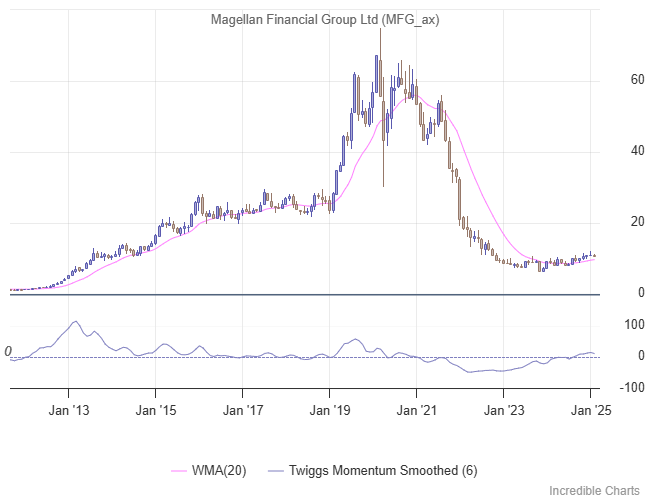Avoiding Value Traps
Thank you to the subscriber who sent the following question that I think would be of interest to most readers:
“I was wondering if you personally use any tools to help you gauge the value of individual stocks? I know that your readings show massively overpriced $SPX, but I believe their may relative values out there if we get a pullback.”
My reply starts with a caution:
The biggest challenge is to avoid value traps, where value looks deceivingly sound, but the low price reflects weaknesses that may not be evident in financial reports. The grass is often greenest over the septic tank.
The chart below shows Magellan Financial Group (MFG)'s rise on the ASX, with a strong balance sheet, excellent cash flows, and stellar return on equity. However, the excellent financials hid inadequate management of key person risk in a company dominated by its founders.

MFG's January 2021 break below its long-term moving average was not a buy opportunity but warned of internal upheaval:
In December 2021, Brett Cairns abruptly resigned as CEO. In the same month, St James’s Place—Magellan’s then-largest investor—also withdrew its mandate. This was followed by co-founder and CIO Hamish Douglass’ indefinite leave in February 2022, which led to his resignation from Magellan in June 2022. (Morningstar)
The Trend is Your Friend
We follow a two-step investment process:
- Buy on technical analysis signals. Wait for a strong uptrend before you buy, no matter how good the value appears on first inspection. The greater the apparent fundamental value, the more wary you should be. The trend is your friend.
- Then, do your homework on the fundamentals and decide whether to keep your position, increase it, or sell if the numbers don't stack up.
Payback Formula
Our simple valuation formula, with adjusted EBITDA, is based on a payback period. This eliminates the need to make assumptions about the weighted average cost of capital (discount rate) and an exit value at the end of the cash flow projection.
Here is a quick summary:
- Calculate free cash flow by adjusting EBITDA for expected capital investment and increases in working capital needed to fund future growth.
- Adjust for expected corporate taxes at a suitable tax rate. Australian investors will need to consider franking credits from the dividend imputation system.
- Project future growth in after-tax cash flows based on past performance, capital investment, market share, and expected market growth. This may be reasonably straightforward for a company like Coca-Cola (KO) compared to a complex operation like Elon Musk's Tesla (TSLA), which we would avoid.
- Sum the resulting net cash flow for a suitable payback period. We typically use a period of between 9 and 14 years, depending on the expected risk and stability of income. Cyclical businesses such as discretionary retail would be on the low end, while Australian consumer staples like Coles (COL), Woolworths (WOW), and some industrial REITS would justify a more extended payback period.
- Compare the resulting sum of free cash flow for the payback period to the company's enterprise value, based on market capitalization plus debt and capitalized leases, to determine whether the stock is at a discount or premium to fair value.
The model ignores the likely exit value if you had to sell the stock at the end of the payback period, which is treated as a "margin of safety." A more extended payback period means less margin of safety and should only be considered for stocks with lower investment risk.
You can find more details at The Patient Investor.
Conclusion
Valuations require considerable time and effort and should not be attempted by inexperienced investors. However, they can provide additional assurance when holding stocks in a strong uptrend.
Always approach any valuation exercise with a view that the stock market may not have perfect knowledge, but it knows a lot more than 99.999% of investors on the planet.
Market Analysis Subscribers
Everything contained in this email, related websites, training videos and training courses (collectively referred to as the "Material") has been written for the purpose of teaching analysis, trading and investment techniques. The Material neither purports to be, nor is it intended to be, advice to trade or to invest in any financial instrument, or class of financial instruments, or to use any particular methods of trading or investing.
Advice in the Material is provided for the general information of readers and viewers (collectively referred to as "Readers") and does not have regard to any particular person's investment objectives, financial situation or needs. Accordingly, no Reader should act on the basis of any information in the Material without properly considering its applicability to their financial circumstances. If not properly qualified to do this for themselves, Readers should seek professional advice.
Investing and trading involves risk of loss. Past results are not necessarily indicative of future results.
You, the Reader, need to conduct your own research and decide whether to invest or trade. The decision is yours alone. We expressly disavow all and any liability to any person, with respect of anything, and of the consequences of anything, done or omitted to be done by any such person in reliance upon the whole or any part of the Material.

Author: Colin Twiggs is a former investment banker with almost 40 years of experience in financial markets. He co-founded Incredible Charts and writes the popular Trading Diary and Patient Investor newsletters.
Using a top-down approach, Colin identifies key macro trends in the global economy before evaluating selected opportunities using a combination of fundamental and technical analysis.
Focusing on interest rates and financial market liquidity as primary drivers of the economic cycle, he warned of the 2008/2009 and 2020 bear markets well ahead of actual events.
He founded PVT Capital (AFSL No. 546090) in May 2023, which offers investment strategy and advice to wholesale clients.
